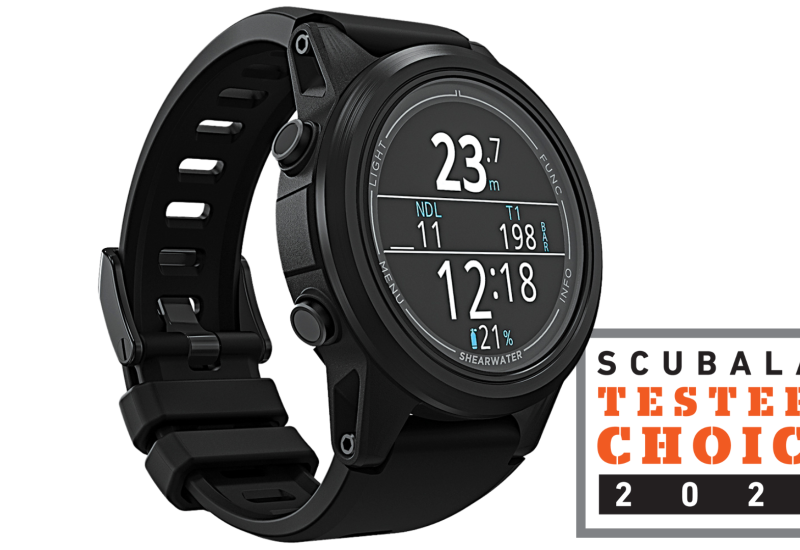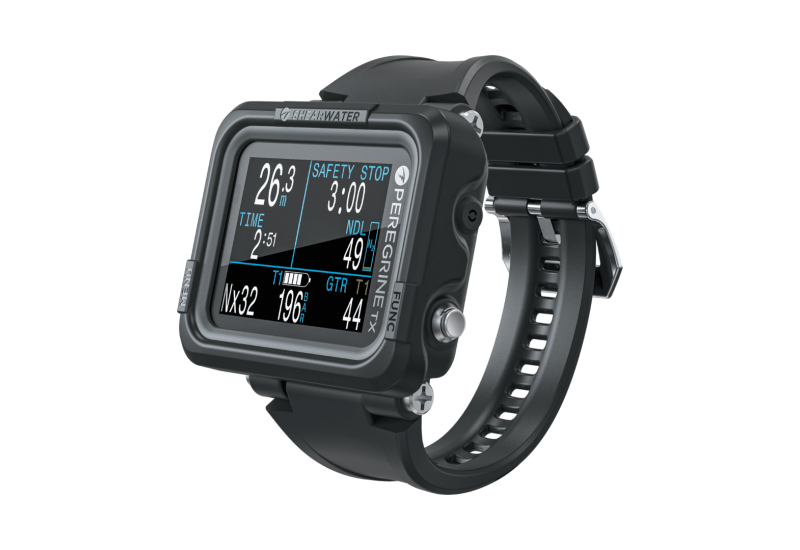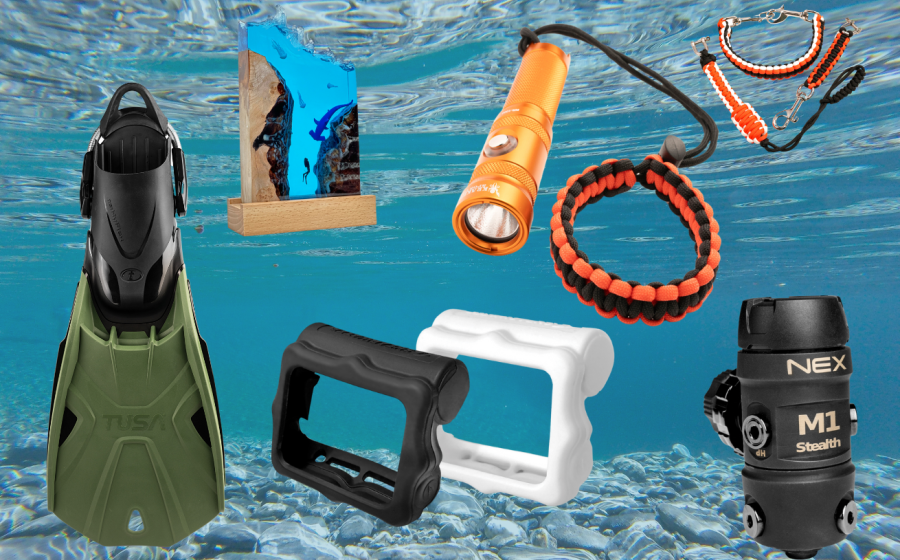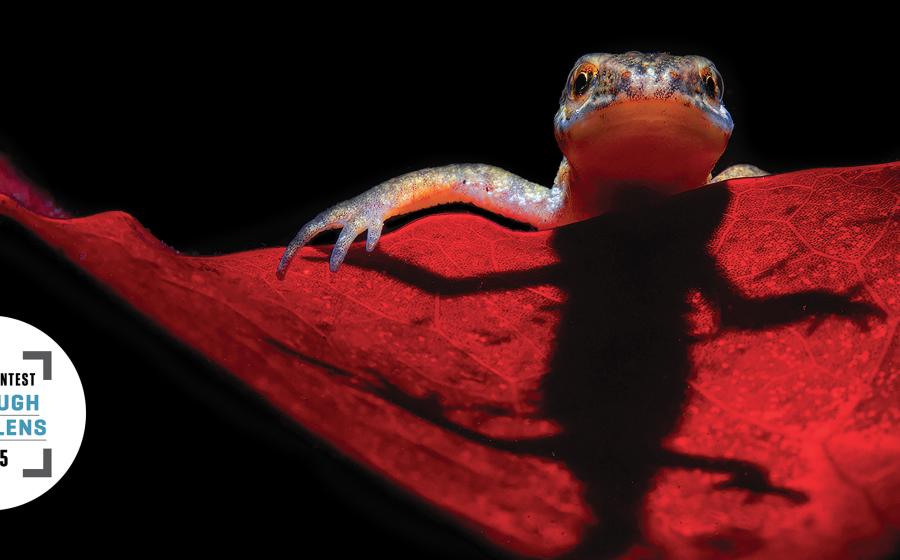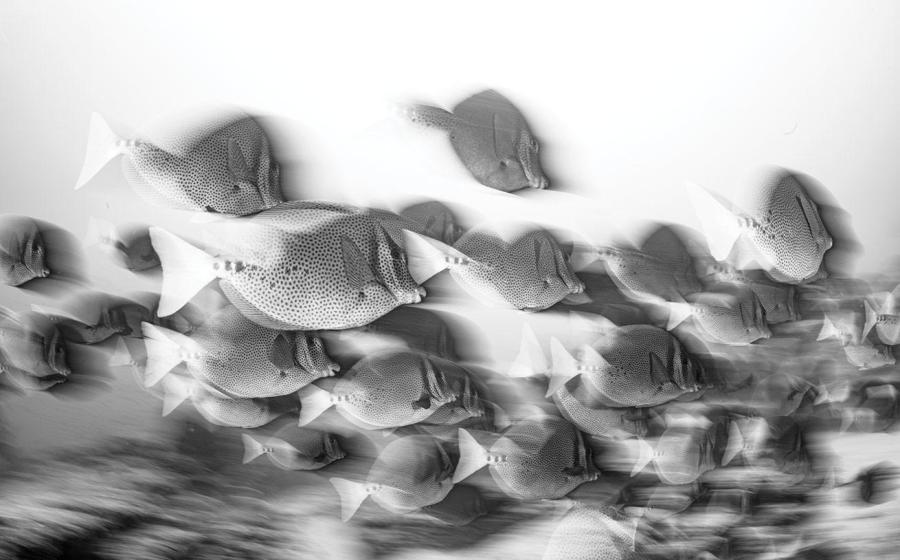DC/PC Interfaces
March 2002
By John Brumm
Interfaces Reviewed in This Article
| Diver's Black Box Genesis ReAct Mares Surveyor Nitrox Interface Oceanic Oceanlog | Scubapro/Uwatec DataTrak Sensus Data Analyst 1.1 Suunto Dive Manager |
Every dive computer has a logbook function that stores data from some number of previous dives and displays it on command. The logical next step, which every dive computer does not have, is the ability to download the data to a PC, where you can attack it with a whole bunch of hertz and display it, in colors, on a big screen.
And why should you want to do that, other than for the strange joy some people get from hammering on a keyboard? You can learn a lot about your dive practices. Chances are, some of what you'll discover will be disturbing.
What You Get
Graphic display: All the download programs let you display your dives graphically, as profiles with depth on the vertical axis and time on the horizontal. When you do that, you're likely to find that your typical profile is a lot more jagged than you thought. You may have imagined a smooth curve that started deep and then went shallower, but in detail, your profile jerks around like an ant track on a dirty table.
Computer data: All the programs display your dive computer data simultaneously. Some even show a realistic picture of your dive computer screen. Click on any point on the profile, and the computer image will display the dive computer data for that point. You may be surprised what you didn't notice during the dive itself. You may even wish your dive computer had more audible alarms.
Violations: Many of the programs flag "violations" like ascents that are too fast, and you're likely to see spots of red or yellow all over your profile. A fast ascent from 80 feet to 70 feet probably doesn't matter, but the same thing from 10 feet to the surface does. In the last few years, downloadable dive computers have revealed that too many divers, thinking the game is over after the safety stop, break the rules in the last 15 feet. Unfortunately, given the importance of a slow ascent, none of these programs displays your actual ascent rate in feet per minute. You're only told it's too fast, or at best, something like "140 percent of maximum."
Simulators: A few of the software packages also include dive simulators, which allow you to create imaginary dives and see the decompression and tissue-loading consequences.
Keep a History
Other than the special features, all these downloaded PC logs are organized about the same way. Dives can be grouped into logbooks, so that several divers can keep logs on the same database. Once you select a dive, you can display general data like location, buddy, weather, etc. (which, obviously, you have added manually) as well as time, date and dive data (from the dive computer). Clicking a radio button or a pull-down menu displays the dive graphically and activates other windows for the dive computer image, tissue loading bar graph, etc. where they are available. Dives can also be sorted and grouped according to various criteria, exported to other databases and printed in various forms.
What if your dive computer is not downloadable? There's a nifty new device called a Diver's Black Box that fills part of the gap.
System Requirements
All these programs have about the same system requirements: a PC with Windows 95 or better, 16MB of RAM, a CD-ROM drive and a mouse. The Uwatec program, though pretty fancy, somehow will work with less. (Macintosh users can forget the whole subject. It ain't happening for you.)
Rating System
Excellent: *****
Very Good: ****
Good: ***
Fair: **
Poor: *
Genesis ReAct: No-Frills Package
||
|---|
|  |
|
Rating: ***
A straightforward program typical of those for the simpler, non-gas-integrated computers.
Several different ReAct computers, representing several different divers, can all be downloaded and stored to the same database, each to its own Personal Log. One nice touch: While you are manually adding personal data like name, address, phone numbers, e-mail address and certifications, you can even add a 2- by 3-inch bitmapped photo.
The profile of the dive appears as a white line on a blue background. The line changes to red if you have ascended too fast. At the same time, numerical data is displayed above and below the graph. Click on any point on the profile, and numbers show depth and dive time at that point, plus no-decompression time remaining, stop depth (if required), temperature and oxygen saturation (for nitrox). VCR buttons give another display option. Click "Play" and the white line crawls across the screen, the numbers above and below changing as it moves.
The data is also available in tabular form, with columns for time, depth, oxygen saturation, ascent rate, temperature, no-deco or deco time, stop depth and note of violation. The sampling rate can be selected, in advance of the dive, on the dive computer.
Help is available on almost every screen, usually by clicking the lightbulb icon. It is thorough and well-illustrated.
This is a straightforward, no-frills display of the basic info, but without the tissue-loading bar graphs and computer face image common to the others. Yes, those are simulations, but they present the information in a form that is immediately understandable.
Price: $180.
Supports: Genesis ReAct.
Contact: Genesis Scuba, (949) 581-1300.
Mares Surveyor Nitrox Interface: Create a Dive
||
|---|
|  |
|
Rating: ****
The first screen displays all logged dives in a list to the left. The main part of the window shows general data for whichever dive you select. Select "Graph of Current Dive" from the Profile menu and you get the familiar dive profile on the main part of the window. To the upper left is a mirror of the face of the dive computer, and below it is a tissue-loading bar graph showing nine tissues. You can use VCR buttons to advance through the dive in 20-second increments, or click on any point in the profile. Violations are shown in yellow or red.
One minor annoyance: The selected point on the profile is indicated by a diver icon. It's cute, but whale-sized on the scale of the profile, so it's not clear exactly what point it refers to.
A very interesting feature is a dive simulator, allowing you to create a dive profile and see what its tissue-loading consequences would be. Profile creation is a little clumsy at the outset, as you have to toggle between ascend and descend arrows and move a speed slider while the "dive" relentlessly marches forward across the screen. But once you've finished, however roughly, you can edit your creation easily. A menu choice highlights all the data points, then you can use the mouse to drag them around until the profile takes the shape you like. Meanwhile, the dive computer mirror and the tissue-loading bar graphs change to follow your edits. Violation warnings also appear and disappear.
The simulator can be a valuable educational tool. It would be nice if you could copy an actual logged dive into the simulator and modify it, but I wasn't able to find a way to do that. Apparently, simulations have to start from scratch.
Price: $149.
Supports: Mares Surveyor Nitrox.
Contact: Mares America, (203) 855-0631.
Oceanic Oceanlog: Graphs Galore
||
|---|
|  |
|
Rating: ***
Version 2.0.3 uses nine-pin serial port connectors instead of the 25-pin parallel port connectors that were causing problems with Windows 2000. Software for all five Oceanic computers, plus a user manual, is contained on the CD-ROM that comes with the download kit. The user manual has complete instructions for installing the proper program and for downloading data from the dive computer to the log.
In my case at least, installation of the software was as easy as it gets: just keep clicking "Next." Downloading, though, can require some quick fingers until you get used to it; the time allowed for initiating download is only seconds for some computer models and it was tricky getting the infrared "nest" to mate with the dive computer. Nor is the download software foolproof--the "Check IR Nest" instructions contain at least one annoying dead end whereby you can't go forward and you're not told why.
Assuming you can get the data into the log, the basic display is very similar to the Genesis ReAct log; obviously, both have the same programmer. What's new is a number of features supported by the more sophisticated of the Oceanic dive computers.
For example, you may see a tissue-loading bar graph, an oxygen bar graph and a breathing gas time remaining bar graph (with gas-integrated computers) above and below the profile. Only a single bar is shown for all tissues; presumably it represents the tissue most saturated. The oxygen-loading bar graph is only active when the computer is set for nitrox.
On-screen help is excellent, answering the questions you actually have with pictorial examples.
Price: $169.95.
Supports: Oceanic Data 100, DataPlus, DataPlus2, DataTrans Plus and DataMax ProPlus.
Contact: Oceanic USA, (510) 562-0500.
Scubapro/Uwatec DataTrak: Bells and Whistles
||
|---|
|  |
|
Rating: ****
The DataTrak download system includes a unique piece of hardware called the "Memo Mouse." It's not a mouse in the conventional computer sense; it's a memory device between the dive computer and the personal computer. What's it for? The Aladin dive computers store only 200 minutes of dive time in fully detailed form--say, four dives. After that, the newest dive starts overwriting the oldest. But if you take the Memo Mouse on your dive trip, you can download to it and store up to 66 hours of dives--and leave your laptop at home. When you get home, you download from the Memo Mouse to your laptop.
The program has lots of bells and whistles. The basic screen lists all logged dives down the left margin and has a control panel across the top. Select any dive and display it in the center, either as a profile or as general data: date, time, location, buddy, weather, maximum depth, minimum temperature, etc.
When displayed as a profile, four types of alarms appear in purple if they are activated. Alarms show for missing a deco stop, for ascending too fast, for using up bottom time and for running low on air (with gas-integrated computers). The sampling rate is 20 seconds.
Three other windows are also available. "Dive Computer" shows the basic numbers on your dive computer. "Physiological Data" shows bar graphs for estimated microbubbles, estimated skin cooling and estimated heart and breathing rate (with gas-integrated computers). A dial graph shows breathing rate (again, with gas-integrated computers). And "Tissue Data" shows bar graphs for eight tissue compartments. All these numbers and graphs change to reflect whatever point you select on the profile. Tissue bars even change color depending on whether you are on-gassing or off-gassing.
The Physiological Data and Tissue Data boxes are particularly fun to look at, as bars move and change colors while you scroll through the dive. It can be hard to remember that these are calculated, predicted data, not actual measurements of your body.
Some modest statistical analysis is possible. You can select any group of dives (or all the dives) and find out the percentage in each depth range, and percentages for air or nitrox, decompression or no-deco, single or multiple ascent, fresh or salt water, etc.
Price: $250.
Supports: Scubapro/ Uwatec Aladin Air Z, Air Z O2, Air Z Nitrox, Sport, Pro, Pro Nitrox, Sport Plus, Pro Ultra, Aladin Air console.
Contact: Scubapro, (619) 402-1023.
Suunto Dive Manager: Mark Your Place
||
|---|
|  |
|
Rating: ***
Along with the familiar profile of each dive, Dive Manager displays a mirror of the dive computer and a tissue-loading bar graph for nine tissues. It displays icons indicating rapid ascents andascents above mandatory safety stops and deco ceilings.
The Dive Manager has a simulator allowing you to create dives. Depths have to be input as numbers on the keyboard and--unlike the Mares simulator--there is no ability to modify the curve by dragging it. Instead, you have to return to a different window and change the numbers you input.
On-screen help is a little sketchy, as if created by someone who never needed it. And printed instructions are nonexistent beyond how to set up the hardware and software. You'll have to learn this program the hard way.
One fun feature: the Suunto computers let you bookmark notable moments in your dive--when you found the sunken treasure, for example. The mark appears on the graphed profile, and you can add a caption like "Treasure here!" Don't get carried away with bookmarking, though, or you'll never remember which is what.
Price: $160-$170.
Supports: Suunto Vyper, Cobra, Mosquito, Stinger.
Contact: Aqua Lung America, (760) 597-5000.
For the Rest of Us: Diver's Black Box and Sensus Data Analyst 1.1
Rating: ****
What if your dive computer is not downloadable? If you like it and are used to it, I wouldn't suggest replacing it just to get download capability. But a halfway (or maybe three-quarters way) step is called the Diver's Black Box. It's a block of aluminum about 2" x 1.5" x 1" that you can hang from your BC or tuck in a pocket and forget about. It activates automatically when it gets wet and records depth and water temperature every 10 seconds as you dive. When you get home, plug it into your PC and download.
The software gives a simplified version of the downloaded logs, with dives listed by Black Box on the left (you can download several boxes to the same software). Click on a dive and see the familiar graphic display, plus a display of water temp through the dive. Click on any point of the depth curve and a data bar displays time, depth, water temp and (hooray!) ascent or descent rate in feet per minute at the selected point. In the middle of the screen is displayed average and maximum depth, average and minimum temperature, and maximum ascent rate. An alternate screen allows you to manually input site name, dive buddy, altitude, salt or fresh water and time zone, and there's a large note box for comments.
The program is limited. You don't get decompression info--the box is a recorder, not a computer. You can't group or sort dives for analysis, and you can't simulate dives. But the basic depth and time picture is there.
The Black Box stores 80 hours of diving at a 10-second sampling rate, and the battery lasts 5 to 10 years.
Price: $75.
System: Requires PC with Windows.
Contact: ReefNet Inc., (888) 819-REEF.
March 2002
By John Brumm
Interfaces Reviewed in This Article
Diver's Black Box Genesis ReAct Mares Surveyor Nitrox Interface Oceanic Oceanlog | Scubapro/Uwatec DataTrak Sensus Data Analyst 1.1 Suunto Dive Manager
Every dive computer has a logbook function that stores data from some number of previous dives and displays it on command. The logical next step, which every dive computer does not have, is the ability to download the data to a PC, where you can attack it with a whole bunch of hertz and display it, in colors, on a big screen.
And why should you want to do that, other than for the strange joy some people get from hammering on a keyboard? You can learn a lot about your dive practices. Chances are, some of what you'll discover will be disturbing.
What You Get
Graphic display: All the download programs let you display your dives graphically, as profiles with depth on the vertical axis and time on the horizontal. When you do that, you're likely to find that your typical profile is a lot more jagged than you thought. You may have imagined a smooth curve that started deep and then went shallower, but in detail, your profile jerks around like an ant track on a dirty table.
Computer data: All the programs display your dive computer data simultaneously. Some even show a realistic picture of your dive computer screen. Click on any point on the profile, and the computer image will display the dive computer data for that point. You may be surprised what you didn't notice during the dive itself. You may even wish your dive computer had more audible alarms.
Violations: Many of the programs flag "violations" like ascents that are too fast, and you're likely to see spots of red or yellow all over your profile. A fast ascent from 80 feet to 70 feet probably doesn't matter, but the same thing from 10 feet to the surface does. In the last few years, downloadable dive computers have revealed that too many divers, thinking the game is over after the safety stop, break the rules in the last 15 feet. Unfortunately, given the importance of a slow ascent, none of these programs displays your actual ascent rate in feet per minute. You're only told it's too fast, or at best, something like "140 percent of maximum."
Simulators: A few of the software packages also include dive simulators, which allow you to create imaginary dives and see the decompression and tissue-loading consequences.
Keep a History
Other than the special features, all these downloaded PC logs are organized about the same way. Dives can be grouped into logbooks, so that several divers can keep logs on the same database. Once you select a dive, you can display general data like location, buddy, weather, etc. (which, obviously, you have added manually) as well as time, date and dive data (from the dive computer). Clicking a radio button or a pull-down menu displays the dive graphically and activates other windows for the dive computer image, tissue loading bar graph, etc. where they are available. Dives can also be sorted and grouped according to various criteria, exported to other databases and printed in various forms.
What if your dive computer is not downloadable? There's a nifty new device called a Diver's Black Box that fills part of the gap.
System Requirements
All these programs have about the same system requirements: a PC with Windows 95 or better, 16MB of RAM, a CD-ROM drive and a mouse. The Uwatec program, though pretty fancy, somehow will work with less. (Macintosh users can forget the whole subject. It ain't happening for you.)
Rating System
Excellent: *****
Very Good: ****
Good: ***
Fair: **
Poor: *
Genesis ReAct: No-Frills Package
Rating: ***
A straightforward program typical of those for the simpler, non-gas-integrated computers.
Several different ReAct computers, representing several different divers, can all be downloaded and stored to the same database, each to its own Personal Log. One nice touch: While you are manually adding personal data like name, address, phone numbers, e-mail address and certifications, you can even add a 2- by 3-inch bitmapped photo.
The profile of the dive appears as a white line on a blue background. The line changes to red if you have ascended too fast. At the same time, numerical data is displayed above and below the graph. Click on any point on the profile, and numbers show depth and dive time at that point, plus no-decompression time remaining, stop depth (if required), temperature and oxygen saturation (for nitrox). VCR buttons give another display option. Click "Play" and the white line crawls across the screen, the numbers above and below changing as it moves.
The data is also available in tabular form, with columns for time, depth, oxygen saturation, ascent rate, temperature, no-deco or deco time, stop depth and note of violation. The sampling rate can be selected, in advance of the dive, on the dive computer.
Help is available on almost every screen, usually by clicking the lightbulb icon. It is thorough and well-illustrated.
This is a straightforward, no-frills display of the basic info, but without the tissue-loading bar graphs and computer face image common to the others. Yes, those are simulations, but they present the information in a form that is immediately understandable.
Price: $180.
Supports: Genesis ReAct.
Contact: Genesis Scuba, (949) 581-1300.
Mares Surveyor Nitrox Interface: Create a Dive
| |
Rating: ****
|
Rating: ****
The first screen displays all logged dives in a list to the left. The main part of the window shows general data for whichever dive you select. Select "Graph of Current Dive" from the Profile menu and you get the familiar dive profile on the main part of the window. To the upper left is a mirror of the face of the dive computer, and below it is a tissue-loading bar graph showing nine tissues. You can use VCR buttons to advance through the dive in 20-second increments, or click on any point in the profile. Violations are shown in yellow or red.
One minor annoyance: The selected point on the profile is indicated by a diver icon. It's cute, but whale-sized on the scale of the profile, so it's not clear exactly what point it refers to.
A very interesting feature is a dive simulator, allowing you to create a dive profile and see what its tissue-loading consequences would be. Profile creation is a little clumsy at the outset, as you have to toggle between ascend and descend arrows and move a speed slider while the "dive" relentlessly marches forward across the screen. But once you've finished, however roughly, you can edit your creation easily. A menu choice highlights all the data points, then you can use the mouse to drag them around until the profile takes the shape you like. Meanwhile, the dive computer mirror and the tissue-loading bar graphs change to follow your edits. Violation warnings also appear and disappear.
The simulator can be a valuable educational tool. It would be nice if you could copy an actual logged dive into the simulator and modify it, but I wasn't able to find a way to do that. Apparently, simulations have to start from scratch.
Price: $149.
Supports: Mares Surveyor Nitrox.
Contact: Mares America, (203) 855-0631.
Oceanic Oceanlog: Graphs Galore
| |
Rating: ***
|
Rating: ***
Version 2.0.3 uses nine-pin serial port connectors instead of the 25-pin parallel port connectors that were causing problems with Windows 2000. Software for all five Oceanic computers, plus a user manual, is contained on the CD-ROM that comes with the download kit. The user manual has complete instructions for installing the proper program and for downloading data from the dive computer to the log.
In my case at least, installation of the software was as easy as it gets: just keep clicking "Next." Downloading, though, can require some quick fingers until you get used to it; the time allowed for initiating download is only seconds for some computer models and it was tricky getting the infrared "nest" to mate with the dive computer. Nor is the download software foolproof--the "Check IR Nest" instructions contain at least one annoying dead end whereby you can't go forward and you're not told why.
Assuming you can get the data into the log, the basic display is very similar to the Genesis ReAct log; obviously, both have the same programmer. What's new is a number of features supported by the more sophisticated of the Oceanic dive computers.
For example, you may see a tissue-loading bar graph, an oxygen bar graph and a breathing gas time remaining bar graph (with gas-integrated computers) above and below the profile. Only a single bar is shown for all tissues; presumably it represents the tissue most saturated. The oxygen-loading bar graph is only active when the computer is set for nitrox.
On-screen help is excellent, answering the questions you actually have with pictorial examples.
Price: $169.95.
Supports: Oceanic Data 100, DataPlus, DataPlus2, DataTrans Plus and DataMax ProPlus.
Contact: Oceanic USA, (510) 562-0500.
Scubapro/Uwatec DataTrak: Bells and Whistles
 |
Rating: ****
|
Rating: ****
The DataTrak download system includes a unique piece of hardware called the "Memo Mouse." It's not a mouse in the conventional computer sense; it's a memory device between the dive computer and the personal computer. What's it for? The Aladin dive computers store only 200 minutes of dive time in fully detailed form--say, four dives. After that, the newest dive starts overwriting the oldest. But if you take the Memo Mouse on your dive trip, you can download to it and store up to 66 hours of dives--and leave your laptop at home. When you get home, you download from the Memo Mouse to your laptop.
The program has lots of bells and whistles. The basic screen lists all logged dives down the left margin and has a control panel across the top. Select any dive and display it in the center, either as a profile or as general data: date, time, location, buddy, weather, maximum depth, minimum temperature, etc.
When displayed as a profile, four types of alarms appear in purple if they are activated. Alarms show for missing a deco stop, for ascending too fast, for using up bottom time and for running low on air (with gas-integrated computers). The sampling rate is 20 seconds.
Three other windows are also available. "Dive Computer" shows the basic numbers on your dive computer. "Physiological Data" shows bar graphs for estimated microbubbles, estimated skin cooling and estimated heart and breathing rate (with gas-integrated computers). A dial graph shows breathing rate (again, with gas-integrated computers). And "Tissue Data" shows bar graphs for eight tissue compartments. All these numbers and graphs change to reflect whatever point you select on the profile. Tissue bars even change color depending on whether you are on-gassing or off-gassing.
The Physiological Data and Tissue Data boxes are particularly fun to look at, as bars move and change colors while you scroll through the dive. It can be hard to remember that these are calculated, predicted data, not actual measurements of your body.
Some modest statistical analysis is possible. You can select any group of dives (or all the dives) and find out the percentage in each depth range, and percentages for air or nitrox, decompression or no-deco, single or multiple ascent, fresh or salt water, etc.
Price: $250.
Supports: Scubapro/ Uwatec Aladin Air Z, Air Z O2, Air Z Nitrox, Sport, Pro, Pro Nitrox, Sport Plus, Pro Ultra, Aladin Air console.
Contact: Scubapro, (619) 402-1023.
Suunto Dive Manager: Mark Your Place
Rating: ***
Along with the familiar profile of each dive, Dive Manager displays a mirror of the dive computer and a tissue-loading bar graph for nine tissues. It displays icons indicating rapid ascents andascents above mandatory safety stops and deco ceilings.
The Dive Manager has a simulator allowing you to create dives. Depths have to be input as numbers on the keyboard and--unlike the Mares simulator--there is no ability to modify the curve by dragging it. Instead, you have to return to a different window and change the numbers you input.
On-screen help is a little sketchy, as if created by someone who never needed it. And printed instructions are nonexistent beyond how to set up the hardware and software. You'll have to learn this program the hard way.
One fun feature: the Suunto computers let you bookmark notable moments in your dive--when you found the sunken treasure, for example. The mark appears on the graphed profile, and you can add a caption like "Treasure here!" Don't get carried away with bookmarking, though, or you'll never remember which is what.
Price: $160-$170.
Supports: Suunto Vyper, Cobra, Mosquito, Stinger.
Contact: Aqua Lung America, (760) 597-5000.
For the Rest of Us: Diver's Black Box and Sensus Data Analyst 1.1
Rating: ****
What if your dive computer is not downloadable? If you like it and are used to it, I wouldn't suggest replacing it just to get download capability. But a halfway (or maybe three-quarters way) step is called the Diver's Black Box. It's a block of aluminum about 2" x 1.5" x 1" that you can hang from your BC or tuck in a pocket and forget about. It activates automatically when it gets wet and records depth and water temperature every 10 seconds as you dive. When you get home, plug it into your PC and download.
The software gives a simplified version of the downloaded logs, with dives listed by Black Box on the left (you can download several boxes to the same software). Click on a dive and see the familiar graphic display, plus a display of water temp through the dive. Click on any point of the depth curve and a data bar displays time, depth, water temp and (hooray!) ascent or descent rate in feet per minute at the selected point. In the middle of the screen is displayed average and maximum depth, average and minimum temperature, and maximum ascent rate. An alternate screen allows you to manually input site name, dive buddy, altitude, salt or fresh water and time zone, and there's a large note box for comments.
The program is limited. You don't get decompression info--the box is a recorder, not a computer. You can't group or sort dives for analysis, and you can't simulate dives. But the basic depth and time picture is there.
The Black Box stores 80 hours of diving at a 10-second sampling rate, and the battery lasts 5 to 10 years.
Price: $75.
System: Requires PC with Windows.
Contact: ReefNet Inc., (888) 819-REEF.


